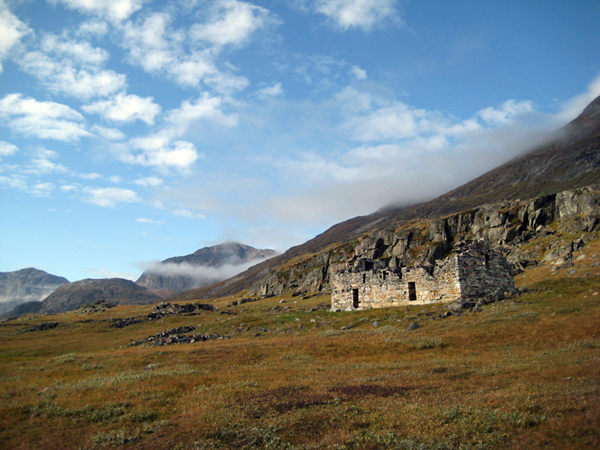A mild Greenland climate in medieval times is no evidence that today’s warming is insignificant. [4 October 2011 | Peter Boyer]

Ruins of a 14th century church at Hvalsey fjord near Qaqortoq in the far south of Greenland, built when the island’s Viking era was coming to an end. PHOTO BROCK UNIVERSITY, ONTARIO, CANADA
“I’m looking forward to a warmer planet,” wrote a Mercury website correspondent last week.
“It’s happened in the past,” he went on. “There’s no doubt the climate is changing — bring it on. Don’t believe it’s man made — there’s just not enough evidence — only vested interests and doomsayers at work here.”
Another in the same batch said: “I’d love to hear Peter Boyer’s explanation why from around 1000 to 1400 AD the Vikings were able to farm in a fairly benign climate in what is now largely frozen waste.” Well, you shall have it.
Ever since Dr Michael Mann’s famous (or for some notorious) “hockey stick” graph was published in 1999, showing modern times being warmer than any other time over 1000 years, those seeking to find flaws in the theory of human-induced warming have argued that medieval times were as warm as today.
“Medieval warming” refers to a period from around 950 to 1250. We can’t be absolutely sure about what happened then, as actual temperature records don’t go back beyond the late 1800s. That said, cross-checking data from tree-rings, ice-cores, corals and sediments can provide a pretty good proxy for the real thing.
The “Medieval Warm Period” anomaly, which is especially marked in data applying to north-eastern North America, southern Greenland and Iceland, is supported by written and archaeological evidence that Vikings settled Greenland and Newfoundland in conditions warmer than anything we’ve known in modern times.
All of which has led many, including my correspondents, to claim that all this talk about modern-day fossil fuel burning causing exceptional warming is, well, just a lot of hot air.
If we were to adopt such a position in formulating policy on climate, we’d want to be very sure of the evidence supporting it. But there are a few problems with the medieval warming hypothesis.
A common criticism is that the idea assumes that what’s happened in one place happened around the globe, sufficient to raise the global average. It’s a similar problem to people living through a cold winter in Washington DC assuming that the whole world is freezing, therefore there’s no global warming. (Don’t laugh — it happens.)
The medieval warming in Greenland and North America seems not to have extended to central and western North America or to central and eastern Europe, where medieval temperatures were if anything cooler. Southern Hemisphere records drawn from corals, sediments and trees are ambiguous. Some of them indicate cooling.
Another criticism is that comparisons with earlier times miss the point about modern warming — that it’s not just the level of current temperatures but also the rate at which warming has occurred.
The best analyses of the 1000-year data suggest that while global mean temperatures for the past few decades have been higher than for any comparable period over that millennium (including medieval times), the early 20th century seems to have been relatively cold.
However, over the past 70 years temperatures have risen (and continue to rise) more quickly than at any time for at least 1000 years. This continuing steep trend is what most concerns climate scientists.
But esoteric arguments over things like the importance of medieval warming can cloud other, more positive, aspects of this debate.
While concerned about warming on a planetary scale, I agree with anyone who says that warming can be a good thing. I’ve been looking forward this spring, as I do every spring, to warmer days and nights, buds bursting open, veggies shooting, being able to get out without rugging up. The dog loves it too.
While the likes of Senator Barnaby Joyce get hot and bothered over the kind of things I write about, we’re all in agreement that changing climate is not in anyone’s interest. We want things to be as they’re said to have been for the Vikings in medieval Greenland — benign.
But the loud, clear message from the work done on the outcome of global temperature rises of 2C or more is that the overall impact won’t be benign. We can choose to disagree, but we’d want to be more sure of our evidence than the Medieval Warming brigade.
Unlike the feisty Senator Joyce who seems to thrive on a good stoush, I don’t appreciate the disagreement and discord that has so clouded discussion about climate and energy. If I’d known how fraught things might become I may never have embarked on this seemingly endless journey.
Anyone who’s interested enough in climate to post a comment on what I write has my respect. If I disagree with what you say, I acknowledge you have every right to say it, and if I’ve seemed unduly disparaging in the past, I’m sorry.
But I’m bound to continue putting the case for curbing our carbon emissions. I can’t do otherwise; the evidence is too comprehensive, too compelling, and far too many of our brightest, most experienced scientists — many of whom I know personally and whose ethical standards I could not question — continue to speak out about it.
I don’t expect all my correspondents to see things this way, but I do believe that we all have a common cause: a better future for humanity and the planet we inhabit. If we can agree on that, it’s a start.
